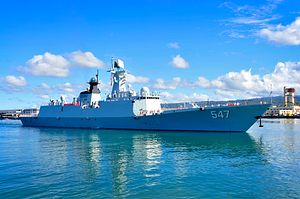Marking a new milestone for China’s People’s Liberation Army Navy (PLAN), two guided missile frigates, reportedly the Linyi and the Weifang, entered the Black Sea on Monday. USNI News broke the story, accompanying it with photographs of the Linyi passing through the Bosphorous on May 4. The pair of frigates are en route to Russia’s naval base at Novorossiysk where they will arrive on May 9 and remain until Chinese President Xi Jinping arrives in Moscow to commemorate the 70th anniversary of the end of the Second World War in Europe.
The two frigates are in the Black Sea after participating with Russia in the first joint Russia-China naval exercise in the Mediterranean Sea. (The Linyi, as some Diplomat readers may recall, drew headlines last month after being used to evacuate Chinese and non-Chinese citizens alike from Yemen amid a Saudi-led bombing campaign there.)
The visit of the two frigates could have commercial intentions as well. A report in the Taiwan-based Want China Times last week made the case that the PLAN was using the Mediterranean exercise as an opportunity to show off the ability of its Type 054A Jiangkai II-class frigates for the Russian Navy. Since the collapse of the Soviet Union, Russia’s surface ship-building capability is known to have taken a great hit.
Russia continues to excel in manufacturing submarines, but its lack of similar capacity with its surface vessels may mean that it would look to purchase vessels off-the-shelf from China. The USNI News report highlights one example of the glacial pace at which one Russian warship builder operates: “it took shipbuilder Severnaya Verf in St. Petersburg seven years to for first-in-class Sergei Gorshkov — from keel laying to commissioning — to enter the Russian fleet after a spate of delays.”
For China, securing a sale of its naval hardware would be a coup, possibly signaling an inversion of the traditional vendor-client relationship between the Kremlin and Zhongnanhai that has mostly run in one direction in the past. China’s own naval and broader military modernization has meant that it has developed its domestic defense industry. As Gabe Collins and Andrew Erickson noted in The Diplomat, back in 2012, China’s military shipyards are building frequently, building well, and building fast.
If Russia is looking to expand its surface fleet, it might make sense for it to buy from China instead of building at home. Doing so would free up some capacity for use in other Russian projects, including its still-strong submarine building program and its other plans to bolster its military capabilities in the Arctic. When it comes to building surface ships, Russia may have to acknowledge that China has the comparative advantage.

































